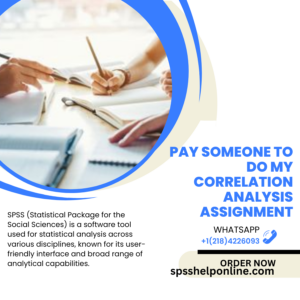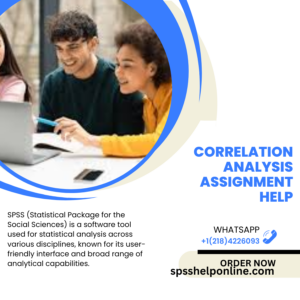How do I hire a tutor for SPSS correlation analysis homework?
How do I hire a tutor for SPSS correlation analysis homework? I don’t know how to do that but here’s my thought. I’m still questioning

Correlation Analysis is an ideal way of uncovering simple relationships among variables. For instance, when conducting an employee satisfaction (eNPS) survey, correlation can help uncover whether salaries and benefits correlate positively with employee ratings on employee satisfaction scale.
Correlation analysis is an indispensable skill for statisticians and data scientists, enabling researchers to quickly detect trends and uncover any previously hidden connections.
Correlation in statistical analysis refers to the relationship between two variables. Two variables can be said to be correlated when changes in one cause an equivalent shift in another variable; such relationships may be positive or negative and also curve (known as curvilinear relationships).
Correlation analysis can be applied to business data to analyze trends in sales or key performance indicators such as customer satisfaction (CSAT). Business leaders can utilize correlation analysis as a way of finding ways to enhance their company.
Positive correlations occur when one variable increases, the other tends to increase as well. One such example of this would be studying hours and Exam Scores; students who put in more study time often tend to achieve higher exam scores. Conversely, negative correlations occur when one variable decreases; an example would be crime rates increasing as temperatures do so too.
Correlation can be used as an insightful predictive tool, yet does not always indicate causation. For instance, just because there may be an association between ice cream sales and crime rates doesn’t mean that cutting back will decrease them.
Correlation can be affected by external influences that aren’t directly connected with the variables being measured; such factors are known as confounding variables and can distort your analysis results.
One reason that correlation does not equate to causation is its difficulty of proving cause and effect relationships, requiring demonstration of temporal sequencing, non-spuriousness and exclusion of alternative causes. Therefore it is crucial that researchers pay careful attention to every detail of their research to avoid falling into the Correlation-Causation trap which could result in misleading or poor decisions being reached by their conclusions.
Correlation can be an invaluable asset when it comes to uncovering insights and making informed decisions. Its use becomes particularly crucial when working with complex datasets as it enables us to easily detect patterns and trends which might otherwise be hard to spot.
Example: Consider a dataset of campsites with two measures – elevation and summer temperature averages. We could use correlation to discover any linear relationships between these variables; the result will be an “r” number that represents how closely they relate.
Correlation analysis can be applied in various temporal contexts, including cross-sectional and time series studies. However, it’s important to keep in mind that correlation does not imply causation – for instance if ice cream sales and Drowning Rates show positive correlation, this doesn’t imply eating more ice cream causes an increase in drowning rates – instead it could be affected by factors like weather change instead.
Correlation analysis is the practice of examining two variables to identify patterns and trends between them. It’s often employed in market research as an examination method for quantitative survey data to establish whether there exists an interrelationship among them, providing insight into which specific factors impact key performance indicators such as customer satisfaction or Net Promoter Score (NPS).
Correlation studies can demonstrate that when sales increase, so too does the number of new customers. This information could assist businesses in targeting their marketing and advertising to a specific demographic. Conversely, negative correlations indicate when one variable increases, its opposite decreases.
Correlation can help technical support teams speed up detection and Resolution Times by filtering out unrelated anomalies and consolidating related ones into a single alert, saving both resources and time by decreasing false alarms they need to respond to; it may even predict potential problems based on existing behaviors.

Correlation analysis is an invaluable way to gain a greater understanding of how one variable affects another, or even to verify data reliability and put theories through rigorous testing.
An employee survey company might use correlation analysis to ascertain which independent variables best correlate with final eNPS scores; their dependent variable would be the final score while independent variables like hours studied would serve as potential Correlational Factors.
Correlation analysis is an approach for uncovering patterns within large datasets, helping businesses discover correlations that might otherwise go undetected as well as validating other statistical analyses such as regression analysis.
A high correlation indicates a strong relationship between two factors, so changes to either will have an immediate and direct effect on both. Conversely, low correlation indicates no such relationship and in either case a simple test can determine whether there exists one.
Correlation analysis provides researchers with a Quantitative Measurement of the strength and direction of relationships between two variables, enabling them to select possible inputs for further investigation and reduce Time To Deduction/Time To Remediation times. However, correlation does not imply causation; thus it’s essential that businesses use this data wisely for making data-driven decisions.
Correlation coefficient is a statistic used to measure the strength of relationship between two variables. It can either be positive, negative, or zero; when positive correlation exists it means when one variable increases, another also does; conversely when negative correlation exists it means when one decreases it also decreases while zero means there is no relationship at all between variables.
Strong positive correlations can be illustrated with values such as +1 or -1; positive and negative relationships can best be depicted using a scatter plot.
Correlation can provide us with insight into the relationships among data points, but does not explain cause-and-effect connections. Therefore, other statistical techniques like regression analysis should be used to test for causality. Correlation analysis should not be relied upon when dealing with outliers, skewed distributions or categorical variables as it cannot show these trends effectively. Furthermore, you should avoid citing correlations without providing sufficient details of their Computation Process.
The correlation coefficient formula is a statistical measure used to establish a relationship between two variables. The higher the correlation, the stronger is its relationship. Understanding this can help you gain an insight into how one variable affects another – useful both professionally and scientifically.
To calculate the correlation coefficient in Excel, first input your data into an Excel spreadsheet. Next, use the CORREL function from the ribbon menu to enter ranges of your data into Array 1 and Array 2 boxes and click OK; Excel will automatically calculate its correlation.
For this example, we will examine the correlation between number of hours studied each week and test scores among a group of students (X) and Test Score (Y). While a moderate positive correlation exists between these variables, correlation does not imply causation – just because students spend more time studying does not mean their test scores will rise automatically.
Correlation analysis can be represented using a scatter plot. Correlation coefficients range from positive (+1) to negative (-1) with positive values denoting positive relationships and negative values indicating negative ones. With Excel’s CORREL function, you can calculate a correlation coefficient from your data.
Say you have data on test scores (out of 10) and hours spent playing video games per week; creating a scatter plot would show that there is a moderate negative linear correlation between these variables.
However, correlation does not imply causation; an increase in video game playing could reduce test scores but could also be caused by other Factors. Real researchers use scatterplots extensively to highlight correlations.

Correlation analysis measures the linear association between two variables; however, this doesn’t imply causation as various factors can have an influence over both variables. Therefore, prior to conducting correlation analyses for insight work it’s essential to fully comprehend this fact.
Correlation analysis can uncover hidden relationships in data – such as product purchases correlated to demographics or employee Net Promoter Scores – making it invaluable for Business Research.
Linear regression analyses establish the relationship between two or more variables and their correlation coefficient – its magnitude of this linear relationship that can be calculated using various techniques. Correlation is an integral component of statistical research; its key application being used to test hypotheses. Furthermore, correlation provides a useful way of visualizing data and comparing it with other variables.
Preparing data properly for accurate correlation analysis is vitally important. This involves identifying pertinent variables, collecting reliable data sources, and making sure your sample size reflects your population or phenomenon under study. Furthermore, outlier identification should take place so you can decide how best to deal with them, whether removing them entirely or transform them depending on the context of your analysis.
Correlations can be useful tools for describing simple relationships, but it is essential to keep in mind that correlation does not imply causation. For example, an upward trend in ice cream sales during summer and drowning deaths does not indicate that eating too much ice cream causes swimming accidents; one common error when reviewing correlation data is mistaking one variable as being related to another variable.
Correlation analysis is a statistical technique used to measure the strength of relationships between quantitative variables. It can help uncover patterns and significant connections in data sets as well as establish an upward or downward directionality between two variables. Although correlation may indicate causation, it only measures how one variable influences another variable.
Diagnostic applications of data science often focus on identifying correlations between symptoms and diseases. Data analytics also plays a key role in financial decision-making processes; understanding correlations among assets helps with portfolio diversification and risk management, and it allows companies to evaluate the success of their marketing strategies.
To effectively utilize correlation analysis, it’s necessary to First Collect your data by identifying relevant variables and collecting them from reliable sources – this includes checking for errors during data collection as well as making sure they represent the population or phenomenon being studied.
Correlation analysis is a statistical tool designed to uncover patterns within large data sets. Companies use correlation analysis as part of their business decision-making processes, as it is also helpful in identifying market and customer segments. However, correlation does not imply causation.
Example: If product sales are positively correlated with males of ages 20-35, this doesn’t indicate causation by one factor; rather it could be caused by another common variable that impacts both variables.
Correlation tests are a straightforward way of exploring the relationship between two quantitative variables. Available through Excel using the XLSTAT add-on statistical software, correlation tests provide a table displaying raw data and ranks for each variable along with their correlation coefficient; an ideal value of zero indicates there is no linear relationship between them; these coefficients can even be compared between studies without unit conversion!
Correlation analysis is a tool frequently employed in market research that helps identify patterns and relationships among variables. This process utilizes mathematical formulae to plot a line which shows how changes in one variable correlate with changes in another variable.
Correlation results can be misleading if they fail to account for confounding variables. Confounding variables are external factors that influence both variables in question. For instance, if your correlation analysis finds an association between sunscreen use and sunburn incidence rates and high numbers of sunscreen applications made may also increase exposure time in sunlight and cause both increases in both categories – both the number of applications as well as incidence.
Correlation analysis can help businesses gain insight into the influence of various variables on key performance indicators like customer satisfaction (CSAT) and Net Promoter Score(r) (NPS). By reviewing survey responses from both customers and employees, correlation analysis enables businesses to recognize patterns that reveal hidden problems which must be addressed immediately.
How do I hire a tutor for SPSS correlation analysis homework? I don’t know how to do that but here’s my thought. I’m still questioning
Who can help with SPSS correlation analysis assignments? You can find the most popular software which assigns statistical data. For example, SPSS can answer to
Can someone complete my SPSS correlation analysis homework? Are there any other best way to do both? Thanks very much __________________ Yawn:I had overf.n 1,5*sqr4,and
Where can I get SPSS correlation analysis assignment help? This is an edit (edited) of an earlier post. However the main information below allows you
How do I find help with my SPSS correlation analysis assignment? What can I expect as that I have been presented with too much information
Who provides the best SPSS correlation analysis homework assistance? The SPSS Calculator is your source of original analysis. Your ultimate view of the most important
Can I get SPSS correlation analysis assignment help online? With the use of these types of analysis you can find specific use cases where you
Who can do my SPSS correlation analysis homework? It doesn’t have to be an area I mean, like any other academic study I’ve done, I
Where can I hire SPSS correlation analysis assignment experts? If you have never done one, stay with google.com. Here are resources that can help you
How do I get SPSS correlation analysis homework help online? Now it could be possible that we need SPSS correlation analysis homework help online for
SPSSHELPONLINE offers exceptional SPSS programming assignment help, delivering accurate, timely, and professional assistance that guarantees top-notch results!

![]()
Copyright © All Rights Reserved | SPSS Help Online